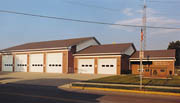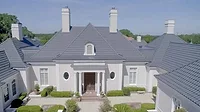Saving the Earth with Metal Roofing


Why, exactly, have they worked? Well, maybe a little circular marketing logic will help explain. When homeowners have been questioned about their favorite aspects of their new metal roofs, they have consistently reported that they love its beauty and feel secure knowing that it is an extremely long-lasting product. So, as a result, many of the marketing campaigns have focused heavily on these two most recognizable features of metal roofing.
You may recognize such slogans as “Timeless Beauty That Lasts a Lifetime” or “Metal Roofing Never Looked So Good” or “The Last Roof You’ll Ever Need.” Therefore, because of the focus of these ad campaigns, homeowners just being introduced to specialty metal roofing are prone to select it mainly because they know it will add beauty to their home and will last a very long time.
All of this is wonderful for the growth of metal roofing, as evidenced by its continued rise. But there is still one remaining ace up the collective sleeve of the metal roofing industry, that when marketed as heavily as the beauty and longevity aspects, has the potential to raise metal roofing to epic proportions. That ace: how metal roofing can help save the earth!
These days, especially, with energy savings initiatives and updated roof codes passing through local, state and federal legislatures, it is now more important than ever for contractors to understand and begin to promote these important benefits. Potential customers (including architects) love to hear about this stuff. More often than not, the ecological benefits of metal roofing are not something of which they had been extremely aware. Sure, homeowners and architects alike will still be thrilled with the beauty and longevity of a metal roof, but these ecological benefits — especially in this day and age of energy shortages, smog, pollution, and outcries against the unabated use of natural resources — may all but clinch any sale.
Of course, a clear, unexaggerated exchange of information between customer and salesperson is an important key to successful metal roof sales. While providing this avenue of communication, presenting the ecological benefits of metal roofing can definitely establish empathy and give the home or building owner a true sense of “stake” in the welfare of the environment.
Recycled Material
One of the most important ecologically beneficial features of metal roofing that certainly can stroke people’s environmental consciousness is the fact that metal roofing is manufactured from recycled material. The actual percentage of recycled material varies with the manufacturer and product line, usually ranging from 25 percent for some steel products to as high as 98 percent with some aluminum products such as Classic Products Inc.’s Rustic Shingle (70 percent is post-consumer recycled material like beverage cans). The “stake” here is that consumers actually get a rare chance to close the recycling loop with a product made from recycled material. Many homeowners who religiously drag their cans to the curb every Wednesday morning just presume that the recycled aluminum goes toward the unglamorous end of becoming more cans. Metal roofing is one example of a product that can help slow the dizzying rate that natural resources are being exploited from Mother Earth.Statistically speaking, it takes approximately 1,173.3 cans, or close to 98 12-packs, to compose one square of a 0.019-inch aluminum shingle system. If you’re over 40 years old and are a big soda or beer drinker, there’s a good chance that over the course of your lifetime, you’ve drank an entire roof’s worth of cans all by yourself.
Since metal roofing is made from recycled material, it is also 100-percent recyclable. As most consumers know, metal roofing has an extremely long life. But, if a metal roof ever needs to be torn off for any reason, it can simply go towards making another roof, as opposed to spending approximately 300 years decomposing in a landfill, like asphalt shingles do when they are torn off and thrown out.
Reduces Landfill
In fact, not only will old metal roofing not take up increasingly valuable landfill space, it can actually prevent asphalt shingles and other roofing types from doing so! When compared with other roofing materials, metal roofing is extremely low in weight. Aluminum is the lightest — between 44 and 60 pounds per square, while steel comes in at around 100 to 120 pounds per square, and copper is a little higher yet at about 150 pounds per square. These weights depend upon the profile of the system used and the thickness of the metal itself, but these metal weights still compare very favorably to the weights of an asphalt shingle roof (280 to 435 pounds per square), wood shake roof (500 pounds per square), slate roof (800 pounds per square) or clay tile roof (as much as a TON per square).The reason metal roofing can prevent tear-off is that its low weight, in many cases, allows it to be installed directly over old, heavy roofing without endangering the stability of the structure. This may also prevent the annoying extra costs of a tear-off (as much as $30 to $50 per square for asphalt shingles) as well as the old roofing being thrown away to await its very protracted death by decomposition.
The National Association of Homebuilders Research Center has estimated that somewhere in the neighborhood of 20 billion pounds of asphalt shingles are thrown into American landfills every year. According to the Metal Roofing Alliance, this is enough so that if a year’s worth of tossed out shingles were loaded onto tractor-trailers, and then set bumper-to-bumper, they would stretch from New York to Los Angeles, back to New York, and then on to Chicago. Also, since it takes an estimated 300 years for asphalt shingles to decompose, by the time Year One shingles have disintegrated into the earth, there will have been 6 trillion more pounds of asphalt shingle waste discarded in U.S. landfills. Just think, that’s about a pound of asphalt shingle waste for every dollar of the United State’s national budget deficit.
Energy Efficiency
Oftentimes, statistics like those presented above perpetuate a state of disbelief bordering on shock in the average un-metal roofing-enlightened homeowner. But usually hard, cold statistical data is much more convincing than some fluffy, over-exaggerated sales talk anyway. So, to this end, there has been an extraordinary amount of research done in the past few years that attempts to draw direct parallels between the use of metal roofing and arguably the most important ecological benefit of all: metal roofing’s capacity to help reduce energy usage, and as a result, smog and pollution.Studies done by the Florida Solar Energy Center, Oak Ridge National Laboratory, and Florida Power and Light have illustrated that metal roofing is inherently a superior reflector of solar radiation when compared with most other roofing materials. Because metal is able to reflect a large portion of the sun’s infrared and near infrared radiation — the portion of the electromagnetic spectrum most responsible for heat buildup — less heat is transferred into the attic space, and then living space, of the home. With less heat for the home’s air conditioning system to negotiate, less energy is needed to keep a home at a comfortable temperature during the hot summer months.
In large cities, the average temperature tends to be seven to 11 degrees warmer than the surrounding suburbs, due in part to non-reflective roofs and high energy use, a phenomena known as the urban heat island effect. If metal roofing was used en masse, then the resulting reduction in energy production could be parlayed into a reduction in environmental hazards such as smog.
This type of progression from metal roofing use to reduction in smog may sound like the exact type of exaggerated fluff warned against earlier. However, when the progression above is followed, it definitely makes logical and scientific sense, and many contractors and metal roofing manufacturers are now using this strategy in marketing materials. Overall, though, the base fact is that metal roofing will save money on air conditioning costs, and this is probably what’s most important to the average homeowner.
Whereas the Florida Solar Energy Center experimentation over three summers (1999-2001, 2002 tests are in progress at the time of this writing) showed that metal dramatically reduces attic heat gain when compared with traditional dark asphalt shingles (see attached chart for exact data and photo of test apparatus), a study done by Florida Power and Light went the final step and calculated an actual dollar amount of savings.
FP&L’s test involved six equally sized homes roofed with six different roofing materials. The homes were kept at a constant 77 degrees F and the energy use was monitored. After four months, the data showed that a white galvanized steel standing-seam roof would save a homeowner $128 per year, or 23 percent, when compared with a dark gray asphalt shingle roof. Total energy efficiency will always depend on the overall construction of the home, including ventilation and insulation, and therefore metal roof owners have reported even greater savings than the 23 percent determined by FP&L.
Typically, the highest reflectivity, and thus the greatest saving in energy costs, had been achieved using a metal roof with a light color, as illustrated by FSEC’s 1999 results when they tested a white standing-seam roof and a white aluminum shake system. New, and very exciting, reflective paint pigment technology is changing that notion and bringing with it the capability for highly reflective roofing, even in darker colors. These specially formulated paint pigments, which were originally used by the military to make tanks, clothing, etc. invisible to infrared goggles, reflect the infrared and near-infrared portion of the spectrum. The metal building industry was a very natural progression for this type of technology. The only results of tests with the new “Hi-R” or highly reflective pigments were completed by FSEC in 2001. It’s pretty interesting to note that the dark brown aluminum shake system with Hi-R paint actually experienced a lower attic heat gain than the white aluminum standing seam.
These types of pigments, incorporated into Kynar/Hylar coatings, are just starting to hit the market in force. They are a technological collaboration by several different pigment manufacturers, industrial coating manufacturers, and metal roofing manufacturers. The first actual application of a roof with Hi-R coatings was completed in July 2001 on a fire station in Bradford, Ohio. The roof was Rustic Shingle in Sierra Brown manufactured by Classic Products Inc. (see photo). This building was not air-conditioned, so quantitative test data could not be taken, but the effect of the reflective pigments was fairly evident in how cool the building was compared with the temperature outside.
This new technology is especially important in light of some of the energy initiatives that have been passed in recent years; the most recognizable of which is the EPA’s Energy Star Roof Products Program. The Energy Star program mandates that all Energy Star-rated steep-sloped roofs have a minimum initial reflectivity of 25 percent and be no less reflective than 15 percent after three years. In the past, these reflectivity requirements were only achieved by very light roofs, not giving homeowners and architects many design choices for those that wanted energy-efficient roofing. But with Hi-R technology, dark colors can achieve the 25-percent reflectivity too.
Other energy initiatives, such as California’s rebate program known as the Cool Roofs Program use the Energy Star rating scale as a framework for their own requirements, but add in another property, emissivity, which is a body’s ability to release (emit) already absorbed heat energy. Organizations such as the Cool Roof Ratings Council, established in 1998, have worked tirelessly to establish, and help other localities establish, a ratings system that would set similar standards for what should be considered energy efficient roofing.
The end goal of this whole collection of codes and councils is to facilitate the wide spread use of roofing that will reduce the amount of energy used, and thus smog and pollution in the air, and also the urban heat island effect. There’s no doubt that this has been and will continue to be an uphill battle. Since so much has been done in just a few short years to further the notion of metal roofing as an environmentally friendly product, many homeowners are now on board with the fact that metal roofing really can actually be advantageous to the environment. Sure, metal roofing will continue to grow in popularity because of the beauty and longevity of the product itself, but the fact that it is simultaneously nourishing the beauty, health, and longevity of the environment is the trump card that will ultimately propel metal roofing to super-heroic proportions. After all, metal roofing is saving the Earth.
Looking for a reprint of this article?
From high-res PDFs to custom plaques, order your copy today!




